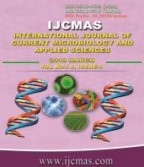


 National Academy of Agricultural Sciences (NAAS)
National Academy of Agricultural Sciences (NAAS)

|
PRINT ISSN : 2319-7692
Online ISSN : 2319-7706 Issues : 12 per year Publisher : Excellent Publishers Email : editorijcmas@gmail.com / submit@ijcmas.com Editor-in-chief: Dr.M.Prakash Index Copernicus ICV 2018: 95.39 NAAS RATING 2020: 5.38 |
The major objectives of the present study were to estimate the incidence of hoof disorders and to identify the various risk factors associated with the hoof disorders in crossbred dairy cattle maintained under field conditions in the state of Karnataka, India. A total of 204 crossbred dairy cattle were investigated for hoof disorders. The overall incidence of hoof disorders was found to be 30.4%. The Holstein Friesian crossbred dairy cows (36.2%) were more vulnerable to hoof disorders than Jersey crossbred dairy cows (20.8%). The age of the animals greater than six years (60%), parity greater than three (44%), body weight greater than 410 kg (43%), animals having white-colored hooves (58.8%), injured hocks (51.7%) and animal having abnormal claw set (32.6%) were significant risk groups for higher incidence of hoof disorders Non-infectious lesions were more common than infectious lesions (94.7 vs 5.3%). Interdigital hyperplasia was the most commonly observed lesion (48.48%) followed by scissor claws (25%), horizontal cracks (18.95%), heel horn erosion (4.54%), white line disease (2.27%) and foot rot (0.76 %). Thus, our study establishes that non-infectious lesions like interdigital hyperplasia, scissor claws, horizontal cracks and white line diseases were the major hoof disorders in the study area compared to infectious lesions (heel horn erosion and foot rot). It can also be concluded that HF crossbred were more vulnerable to hoof disorder than Jersey crossbred and there was an increase in the incidence of hoof disorders with the advancement of age, higher body weight, light coloured hooves, injured hock conditions and abnormal claw set in crossbred dairy cattle.
 |
 |
 |
 |
 |